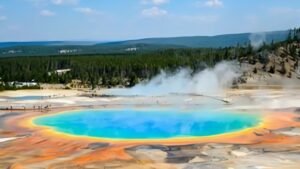
The Yellowstone Supervolcano is a massive geological feature located in Yellowstone National Park. Its potential to cause a catastrophic explosion has captivated the interest of scientists and the public alike. This article delves into the science behind the Yellowstone Supervolcano, the potential consequences of an eruption, and ongoing efforts to monitor and prepare for such an event.
What is the Yellowstone Supervolcano?
Spanning about 30 miles in diameter, the Yellowstone Supervolcano is an extensive volcanic caldera. It’s classified as a supervolcano due to its ability to produce an eruption with a magnitude of 8 on the Volcano Explosivity Index (VEI), signifying that it can release over 1,000 cubic kilometers of material. The last major eruption occurred about 640,000 years ago, creating the Yellowstone Caldera. More recent activity includes smaller eruptions, with the latest lava flow occurring around 70,000 years ago.
The Science of Supervolcano Eruptions
Supervolcano eruptions are some of the most devastating natural events, capable of altering the global climate, causing mass extinctions, and reshaping continents. The key components involved in such an eruption include:
- Magma Chamber: Beneath Yellowstone lies a vast chamber filled with partially molten rock.
- Pressure Build-up: Over time, pressure builds within the magma chamber. When this pressure exceeds the strength of the overlying rock, it can lead to a catastrophic eruption.
- Ash and Pyroclastic Flows: An eruption would release a massive cloud of volcanic ash into the atmosphere, spreading over vast areas. Pyroclastic flows—fast-moving currents of hot gas and volcanic matter—would devastate the surrounding landscape.
Potential Consequences of a Yellowstone Explosion
The repercussions of a Yellowstone eruption would be extensive and catastrophic:
- Global Climate Effects: The eruption would inject large amounts of ash and sulfur dioxide into the atmosphere, leading to a volcanic winter. This could result in a significant drop in global temperatures, affecting agriculture and causing food shortages.
- Widespread Ashfall: Volcanic ash would spread across North America, impacting air travel, infrastructure, and health. The ash can cause respiratory issues, contaminate water supplies, and disrupt transportation networks.
- Economic Impact: The economic cost of a Yellowstone eruption would be immense, with damage to infrastructure, agriculture, and industries. Long-term economic recovery would be challenging.
- Environmental Devastation: The eruption would cause widespread destruction of ecosystems, including the loss of plant and animal species. The landscape would be dramatically altered, with rivers, forests, and wildlife habitats severely impacted.
Monitoring and Preparation
Given the potential consequences, monitoring the Yellowstone Supervolcano is a top priority for scientists. The Yellowstone Volcano Observatory (YVO), a partnership between the U.S. Geological Survey (USGS), Yellowstone National Park, and the University of Utah, continuously monitors the area for signs of volcanic activity. Key monitoring techniques include:
- Seismographs: These instruments detect earthquakes, which can indicate movement of magma beneath the surface.
- GPS Measurements: Global Positioning System (GPS) stations measure ground deformation, which can signal magma movement.
- Gas Emissions: Monitoring volcanic gases helps scientists understand the state of the magma chamber.
- Remote Sensing: Satellite imagery and other remote sensing technologies provide valuable data on changes in the landscape and thermal activity.

The Path Forward
While the potential for a Yellowstone explosion is a serious concern, it is important to understand that such an event is not imminent. Current monitoring efforts provide valuable data that help scientists assess the likelihood of an eruption and implement necessary precautions. By staying informed and prepared, we can mitigate the risks associated with this powerful natural feature.
The controversy surrounding this potential event underscores the ongoing debate about the role of scientific understanding and preparedness in public safety. As research and monitoring continue, the knowledge gained will be crucial in mitigating the risks and managing the impacts of a possible eruption.
For more detailed information on this topic and related news, visit Americana Pulse.
For more information, visit this link.
Tags,
Yellowstone Supervolcano, Volcanic Eruption, Geothermal Activity, Volcanic Monitoring, Supervolcano Consequences, Yellowstone National Park, Geological Features, Volcanic Preparedness, Earth Sciences, Environmental Impact
